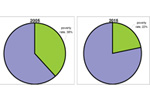UN DESA | DPAD | Development Policy Analysis Division
Capacity Development and Advisory Services
Millennium Development Goals
South Africa highlights
Achieving development goals would require a rapid increase in annual public spending
 |
In order to achieve development goals in primary education, mortality, and water and sanitation, South Africa's government would need to scale up MDG-related spending from 3% of GDP per year on average in a business-as-usual scenario, to 12% per year by 2015. Meeting the targets on reducing child and maternal mortality rates will be the costliest, requiring spending more than 5% of GDP per year until 2015. If no measures are taken, including improving the efficiency of spending, and given the challenges posed by HIV/AIDS prevalence, both maternal and child mortality rates are estimated to rise by 2015.
Spending on development goals would require broadening
the tax base
| Tax revenues of Central Governments in 2005 (% of GDP) |
 |
Financing additional MDG-related spending through tax revenues is one possible financing option. However, South Africa's relatively high tax burden leaves the country with limited space for increasing tax revenues. In 2005, tax revenue represented 28% of GDP, similar to developed countries such as the United States, notably exceeding the average tax revenue levels of African countries. Achieving the MDGs would require raising tax revenues by 10% of GDP. This would make South Africa's tax burden equal to that of EU countries and would likely be politically unfeasible. Revenues will have to be raised by pursuing policies that help broaden the tax base.
Poverty and inequality are projected to decrease under favourable labour market conditions
| Per cent of the population living for less than $1.25 per day, 2005 and 2015 |
 |
Scaling up public spending for financing MDG gaps would foment aggregate demand and improve the employment outlook. The resulting lower unemployment and higher wages would reduce the incidence of extreme poverty, and labour incomes would be more equally distributed according to the Gini coefficient. South Africa could then meet its target of reducing the incidence of extreme poverty by 25% in 2015, as a positive externality of targeting MDG gaps in education, health, and water and sanitation.
Related documents
- Country study "Assessing Development Strategies to Achieve the MDGs in the Republic of Senegal" (2011).
- Country study "Assessing Development Strategies to Achieve the MDGs in the Republic of Uganda" (2011).